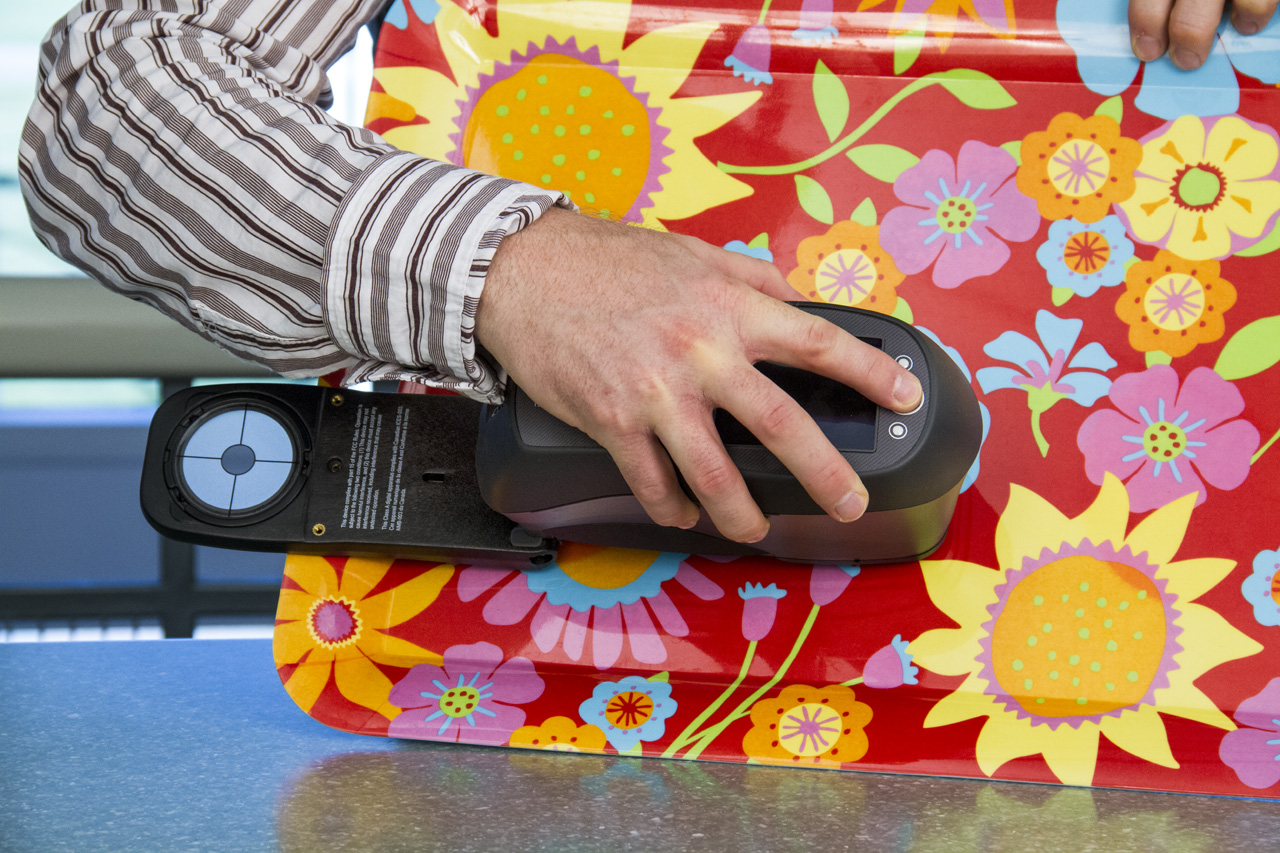Colorimeters and spectrophotometers are color measurement devices that are used to capture, communicate, and evaluate color. From cardboard packaging to food, laundry soap, carpeting and small plastic parts, color measurement devices help ensure the color being produced matches the color that was originally specified. They’re used behind the scenes in just about every industry where color is important, including plastics, textiles, paints, coatings, print and packaging.
There are basically two types of color measurement instruments: colorimeters and spectrophotometers.
What Is A Colorimeter?
A colorimeter is a device that mimics the way humans perceive color.
How does a colorimeter work?
Using an internal light source, a colorimeter shines light down onto the surface of the sample. As the light reflects back up to the device, it passes through three filters: red, green and blue. These filters distill tri-stimulus (RGB) values that match how our eyes see color.
Common colorimeter applications:
Colorimeters can be used to calibrate computer monitors to ensure the colors you see on screen are accurate. They’re also used to specify color. Designers can carry them around to capture inspiration colors for use in their designs. However, colorimeters are limited in their capabilities. Since they are blind to metamerism (a common phenomenon that occurs when two colors appear to match under one lighting condition but not when the light changes), they aren’t ideal for all production applications, especially formulation.
What is a spectrophotometer?
Spectrophotometers allow for more sophisticated color measurements and can capture more data related to color.
How does a spectrophotometer work?
A spectrophotometer works almost same way, except for one main difference – the filters. Instead of using three filters to determine the RGB values of the color like a colorimeter, modern day spectrophotometers typically have 31 filters to measure the full color spectrum. These filters measure light in each of 31 different wavelengths to determine the color of the sample.
Spectrophotometers come in many shapes and sizes, from small handheld devices to large benchtop workhorses, to in-line devices used during manufacturing production. Since they can evaluate how color will look under different light sources, spectrophotometers are ideal for identifying metamerism.
Common spectrophotometer applications:
Spectrophotometers can measure just about anything, including liquids, plastics, paper, metal and fabrics. There are three primary types:
- 0º/45º (or 45º/0º) instruments present light at a fixed angle to the sample, and can exclude gloss to most closely replicate how the human eye sees color. They are commonly used for measuring color on smooth or matte surfaces.
- A spherical instrument presents diffused light and can measure both excluding gloss (SCE) and including gloss (SCI). They are commonly used for measuring color that has been applied to textured surfaces such as textiles, carpets and plastics, as well as shiny or mirror-like surfaces, including metallic inks, printing over foil, and other highly glossy surfaces.
- A multi-angle instrument presents light at a single angle but measures at multiple angles – essentially seeing the color of a sample as if it is being moved back and forth – just as you would tilt a sample to see the color at various angles. Today’s multi-angle instruments are used for specially coated pigments and effect coatings with additives like mica and pearlescents, used in applications such as nail polish and automotive coatings.
Many spectrophotometers can measure in transmission mode to quantify the opacity and haze of a sample. They can also compensate for optical brightening agents, chemicals that manufacturers add to products like paper, plastics, and textiles to make them appear whiter and brighter,
Today’s spectrophotometers are built to support a connected color management strategy while delivering the most reliable, repeatable, and accurate measurements between operators and across manufacturing sites.
Which color instrument is right for you?
It all depends on your application and price range. The higher the resolution of the instrument, the better job it can do. Colorimeters are a great way to capture color and do basic evaluation for applications that don’t require tight color control. Since spectrophotometers measure the entire spectrum instead of just red, green and blue, they provide more accurate color data; making them useful for a broad range of applications in R&D, color formulation, and quality control.
If you’re ready to enter the world of color measurement, get in touch. Our color experts would love the opportunity to help you decide which device is best for your needs.


